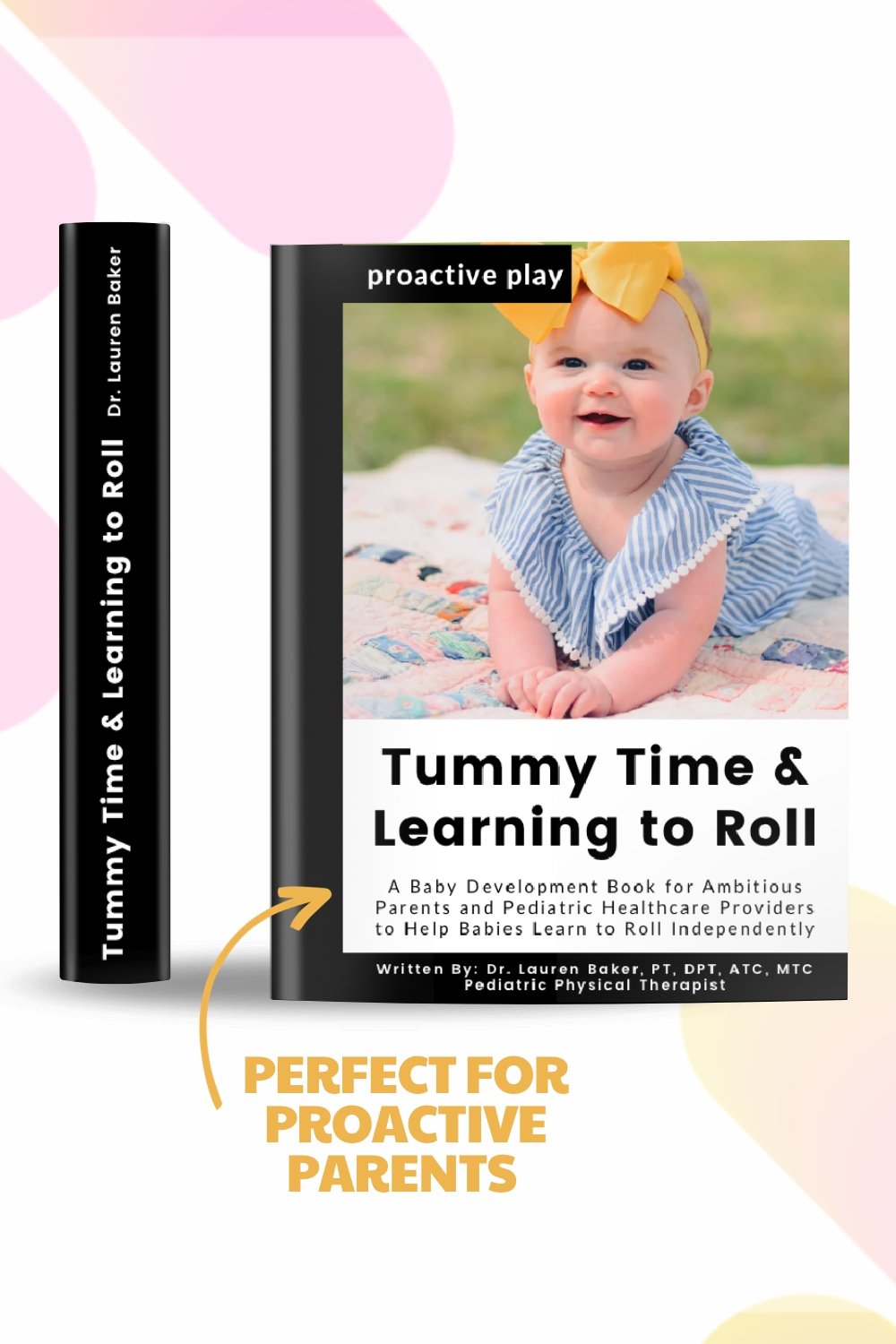How To Help An Infant Learn To Roll Over Using The Simple Open Book Exercise
this blog contains affiliate links
Hi there! I’m Dr. Lauren Baker, a Pediatric Physical Therapist, and I’m here to be your guide on this exciting journey of helping your baby learn to roll over with confidence and ease.
Today, we’re diving into one of my favorite exercises designed to increase upper trunk rotation, a crucial skill for babies learning to roll from belly to back.
This exercise is especially helpful for babies who are learning or struggling to roll over from their belly to their backs, but can also be used for general rolling development.
The Key: Upper Trunk Rotation
For a baby to roll smoothly and repeatedly in both directions, they need to master rotating the top half of their body independently from the bottom half.
The best way to think about this is to imagine sitting and rotating your upper body while keeping your lower body still; like sitting in a chair with your legs pointing forward and rotating your shoulders to look behind you.
This is also what we aim for our little ones to achieve, because without this motion, they will likely get stuck. Sometimes, babies do have this motion but only in one direction. That’s why I love this exercise because it can be done on both sides.
Sometimes we forget that babies need a handful of things in order to be able to do one simple action like rolling. They need strength, coordination, AND mobility of their body and not just ONE part of their body, but multiple parts: their head/neck, arms, eyes, upper trunk, lower trunk, and legs.
This exercise is also great for babies who roll belly to back on their own, but smash their sweet, soft little heads on the ground. They basically are catapulting themselves from belly to back, often because they have good arm strength (yay!) but are lacking trunk mobility.
So because they do not yet have the flexibility they need to do it smoothly and softly, they end up throwing themselves over their arms/shoulders and landing kind of hard on their backs because gravity is always trying to push them to the ground.
When they catapult themselves over their shoulders, gravity takes that force they generated and increases their speed, which then results in a hard “bounce” on their back and potentially their heads!
The Exercise That Will Help You Learn How To Teach Baby To Roll From Tummy To Back
For the most comprehensive information, please watch the youtube video here. It will go through exactly how to do this on a real baby :)
Positioning: Start with your baby in a belly (prone/tummy time) position.
The Roll: Gently roll your baby over to their side, ensuring their elbow is tucked in front of their body. Hold them into a side lying position, stabilizing their pelvis on the top by gently holding your hand on the top part of their pelvis. This may require a little more, but still gentle force as babies will likely be confused and try to roll onto their back.
The Rotation: Bring a toy behind them so that they reach for the toy with their top hand/arm, in an “open book,” type position. This is similar to an adult stretching position where you lie on your side and bring your top arm behind you to “open and close” your chest. This is meant to encourage upper trunk rotation.
Keep Them Motivated: Babies often will engage in this position for a short period of time 15 seconds to 1 minute (closer to 1 minute is ideal) and then you will need to allow them a break to play or place the toy in their mouth. By doing this in “repetitions” to the babies tolerance you will keep them motivated and decrease their frustration, while still getting the motion you want.
Engagement: Use toys or visual cues to engage your baby, if they are disinterested or struggling, make sure that their eyes are looking at the toy as they turn. This will help encourage them to reach and explore, enhancing hand eye coordination and strengthening their muscles.
TIMESTAMPS:
3:55 trunk rotation exercise to help infant learn to roll over
TOY IDEAS:
Squigz with Rings
Orange Squigz with Rings
Squigz Bundle
Moose Toy
Bumpy Ball
Best Toys for Babies Learning to Roll
Best Toys for Babies
PT Approved Equipment/Containers for Babies
Tummy Time Toys
Key Points to Remember
Repetition: Perform this exercise in repetitions, focusing on both sides equally. Babies often have a preferred side for rotation; your goal is to encourage balance and ease in both directions.
Engagement and Breaks: Keep your baby engaged with toys and take breaks as needed. It’s essential to make the exercise enjoyable and not overwhelming.
Observation: Pay attention to your baby’s ease of movement on each side. If one side is more challenging than the other, that might be due to a mobility restriction. Use this information to tailor your approach, focusing more on the difficult side while still maintaining a balanced routine.
It is also important if there is a difference side to side to try to resolve it as much as possible, look into TMR positional releases, which are my favorite ways to assist babies in improving their mobility and being able to move equally side to side in the easiest, least stressful way possible.
Why This Exercise Matters
This exercise is not just about rolling; it's about building the foundation for future movement skills. By focusing on upper trunk rotation, you're helping your baby develop the coordination, strength, and flexibility needed for crawling, sitting, and eventually walking.
Rolling is one of the most important milestones, if rolling is mastered in all four directions (belly to back over left / belly to back over right / back to belly over left / back to belly over right) babies are at a much less risk of developing non-optimal crawling patterns or difficulty with crawling.
Crawling is one of the key movement patterns needed for pre-academic skills including reading and writing.
Additional Tips
Variety: Mix up the exercises. If you notice your baby prefers rolling to one side, incorporate activities that encourage rotation to the less preferred side.
Duration: Spend about two to five minutes on each exercise (it’s okay if it takes multiple repetitions to add up to 2-5 minutes). Start with the easier side to build confidence before moving to the more challenging side.
Integration: Combine this exercise with other activities from the rolling playlist or check the bottom of the blog post to see all our rolling content to ensure a well rounded development.
Curious About Learning More on Tummy Time, Rolling, or Both?
The absolute best book for parents on tummy time and rolling is: Tummy Time and Learning to Roll: A Baby Development Book for Ambitious Parents and Pediatric Healthcare Providers to Help Babies Learn to Roll Independently. The book comes with a free online video course to help parents fully understand how to complete the different exercises, printable checklists to know exactly where your baby is at, and when to reach out for additional help.
This book was written by Dr. Lauren Baker, PT, DPT, ATC, MTC, who is a Pediatric Physical Therapist in Boise, Idaho, trained in helping parents learn how to help their babies move and master their milestones. She loves teaching parents how to see how their babies are moving as well as how to influence those movements though play positions and exercises to help babies move with confidence and ease.
Tummy Time and Learning to Roll is the first book in the Proactive Play series written by Pediatric Physical Therapist Dr. Lauren Baker in order to help Ambitious Parents and Pediatric Healthcare Providers learn how to help babies master tummy time and learn to roll. It is meant to help ambitious parents understand baby development from birth to six months (tummy time to rolling).
This book is a mix of easy-to-follow and more in-depth information than is typically found in baby development books because Dr. Baker believes parents deserve to have all the information at their fingertips.
This book breaks down each piece of movement in checklists so that parents know what their babies need for tummy time and rolling. It also covers what areas might limit a child with rolling, why it is so important, and when to seek help from a pediatric PT.
This book comes with colored photos and easy-to-follow demonstration videos that can help parents implement safe, strategic play-based exercises with their babies in 20 minutes per day.
A Great Resource For:
Parents and Pediatric Healthcare Providers of babies 0-6 months
Parents of babies who are struggling with tummy time, rolling back to belly, belly to back, or only to one side
Access to simple, easy-to-follow videos of play positions and exercises
Learning the four pillars of movement needed in order to master rolling
240+ Color Photo Examples of:
Tummy Time, Sidelying, and Back Play
Developmental Toys and Equipment
Hand Placement and Strategic Play Positions
Common Areas of Restriction or Weakness
When To Reach Out For Help
What If You Want Extra Help?
If you have concerns about their movement, remember, you can always reach out to a pediatric physical therapist. It's your right as a parent to advocate for your child's development.
Sometimes, a few tips and tricks are all you need to get your baby moving better. We're here to support you and release those mama worries. If you are looking for in home pediatric physical therapy, check our listing of therapists.
For those eager to learn more or seeking personalized guidance, I offer online video parent consultations internationally which can be scheduled by clicking here. I am dedicated to answering questions and providing tailored play activities for each unique developmental journey.
When Should Babies Receive Pediatric Physical Therapy?
Parents can call and schedule with a Pediatric Physical Therapist at any time, for any concern in all fifty states without a referral from their Pediatrician.
Pediatric Physical Therapy is medically indicated in all babies who are not rolling in all four directions by six months (back to belly over their right arm AND left arm + belly to back over their right arm AND left arm).
Pediatric Physical Therapy is medically indicated if you notice a flat spot on the back of an infants head (possible plagiocephaly), a tilt of their head consistently to one side (ear to shoulder - possible torticollis), or a rotation preference of their neck (consistently look only to the right or left - possible torticollis).
Many Pediatric Physical Therapists including Dr. Baker, can successfully treat flat spots (Plagiocephaly) without a helmet with a combination of therapy and positioning strategies if seen prior to 4 months (0-3 months is ideal). Dr. Baker uses the Baby Begin Method of repositioning.
Flat spots can be due to in-utero positioning, rotational preference (right sided flatness most common) and babies are at an increased risk for flatness if they are male, were breech, multiple birth, premature, have difficulty with tummy time, or are in containers > 2 hr/day.
Final Thoughts
Thank you for joining me in learning how to support your baby’s journey to mastering rolling belly to back. Remember, every baby is unique, and progress will vary. The key is patience, consistency, and celebrating every little victory along the way.
If you have any questions or need personalized advice, feel free to reach out for an online parent consultation. Together, we can ensure your baby develops the skills they need to move confidently and with ease. Until next time, keep nurturing your baby’s movement adventures with love and encouragement. Here’s to happy rolling!







